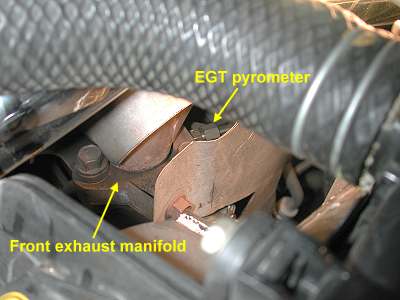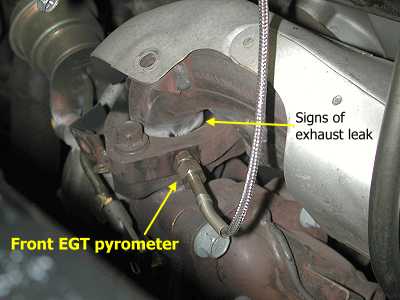EGT Pyrometers
in the Mitsubishi 3000GT & Dodge Stealth R/T TT
by Jeff Lucius
Exhaust gas temperature (EGT) is used for tuning and as a warning indicator. The EGT suggests whether the air-fuel ratio (A/F) is relatively rich or lean. This information is most useful during wide open throttle (WOT) engine operation. At WOT, values between 850ºC (1562ºF) and 900ºC (1652ºF) are often considered ideal; temperatures below 800ºC (1472ºF) are considered too rich; temperatures above 925ºC (1697ºF) and approaching 1000ºC (1832ºF) are considered dangerously lean and can result in excessive engine detonation (knock) and possibly burnt or melted components (valves, spark plugs, pistons, rings). The placement of the EGT probe affects the measurement (the farther the probe is from the head exhaust port the cooler the temperature can be) as does the amount of ignition timing advance (more advance can mean cooler temperatures).
Because the engine computer controls fuel injection in each cylinder separately, and because a dangerous (lean) situation can develop in any cylinder or in either bank, there should be an EGT probe installed in each exhaust manifold. Ideally, each cylinder exhaust port should be monitored, but that is rarely practical. With the engine in the car, the rear manifold can be hard to get to, so many owners elect to install one probe in the front exhaust manifold. This is definitely better than no EGT probe!
To get useful temperatures, the probe must be installed in the exhaust manifold, that is, "before" the turbocharger. The farther the probe is away from the head exhaust port, the cooler the temperatures will be. Most owners install the probe near or in the exit flange of the manifold after the three runners have joined and the temperatures from each cylinder have combined. The rear manifold on our engines is made of cast iron, the front is welded steel. Because of this and the longer length of the front runners, the front EGT may be 50ºC to 100ºC (90ºF to 180ºF) cooler under some engine conditions. Some owners install the probe in the downpipe (after both turbos). Temperature from this location is minimally useful for either tuning or warning because the long distance from the head creates a long feedback delay and the turbos affect the temperature.
I recommend an EGT probe and gauge combination that reads to at least 1000ºC. Autometer gauges read only to 1600ºF (871ºC), which limits their usefulness [Update 2-17-05: I have heard that Autometer now offers a 2000ºF EGT Gauge; http://www.egauges.com/ has good prices]. GReddy gauges read to 1200ºC (2192ºF). Sources for Greddy gauges include RacingWorks.com and ProStreetOnline.com as well as many other vendors. Team Rip Engineering offers a replacement probe that is compatible with the GReddy gauge for $45. This probe has a maximum temperature tolerance of 2200ºF and maximum continuous temperature tolerance of 1785ºF (973ºC). A'PEXi makes EGT gauges that read to 1200ºC. These are available at Import Power Online and other vendors.
Readers please note that I did not install these pyrometers and so have no instructions for doing so. The mechanic that rebuilt my engine installed these pyrometers while the engine was out of the car. Instructions for installing the GReddy 60-mm gauge and probe are available online at http://mkiv.com/techarticles/greddy_egt/.



Page last updated February 17, 2005.





